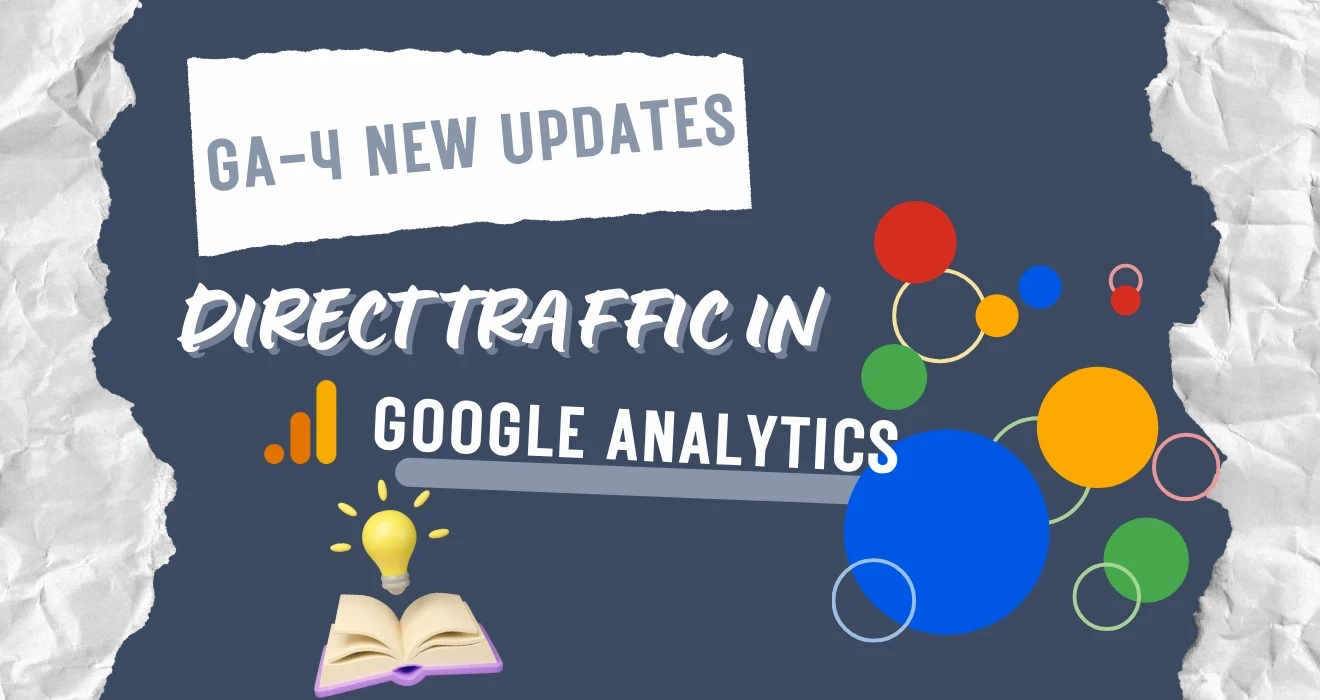As someone deeply involved in web analytics, I often encounter the enigmatic Direct Traffic in Google Analytics. It's that portion of the traffic pie chart that can feel like a black box, leaving you wondering about its true origins. Is it a surge of loyal customers? Activity from those elusive dark social channels? Or perhaps just a reflection of incomplete tracking?
My journey to truly understand direct traffic in Google Analytics has been eye-opening, moving beyond mere academic curiosity to a practical understanding of where our growth genuinely stems from. In this review, I'll share my insights on dissecting this traffic source, identifying the causes of sudden spikes, and, most importantly, transforming these seemingly mysterious visits into tangible revenue.
What is Direct Traffic in Digital Marketing?
For fellow marketers pressed for time, here’s a concise overview of what I've learned:
|
Question
|
Key Insights
|
|
What is direct traffic?
|
Sessions where Google Analytics lacks referrer data - encompassing typed URLs, bookmarks, dark social, app links, and HTTPS to HTTP transitions.
|
|
Direct vs. organic search?
|
Organic traffic originates from search engine referrals; direct traffic represents all sessions where the source isn't identifiable.
|
|
How to minimize mislabeled direct?
|
Implement UTM parameters, ensure comprehensive HTTPS coverage, tag email links meticulously, and configure app-link attribution.
|
These quick insights directly address common questions and provide a roadmap for a deeper understanding.
What is Direct Traffic to a Website?
Think of analyzing your website traffic as examining the ingredients of a complex dish. When a significant portion is labeled "Direct," it's like encountering unlabeled components, they contribute to the overall flavor, but you're unsure of their exact nature.
Types of Direct Traffic in Google Analytics - A Complete List
In both Google Analytics 4 (GA4) and its predecessor, Universal Analytics (UA), "Direct" serves as the catch-all for sessions where the referral source remains unknown. However, my analysis has revealed that this category encompasses a diverse range of user behaviors:
● True Direct Navigation: Users who directly input your website address into their browser or utilize a saved shortcut. This often signifies strong brand recognition and a higher likelihood of conversion.
● Bookmarked Visits & Homescreen Access: Returning users who have saved your site in their browser favorites or added it as a Progressive Web App (PWA) icon on their mobile devices.1 These are typically repeat customers engaging with your content or checking for updates.
● Dark Social Activity: Links shared through private messaging platforms like WhatsApp, Slack, Discord, and SMS.2 These channels often strip referrer information, and I've observed this traffic being predominantly mobile-driven, with peaks during evenings and weekends.
● Desktop Email & Untracked Documents: Traffic originating from desktop email clients (like Outlook) or links embedded in documents such as PDFs and PowerPoint presentations.3 Particularly in B2B contexts, shared presentations can lead to direct traffic spikes that are often overlooked.
● HTTPS to HTTP Referral Loss: A critical technical aspect – if your landing pages still operate on HTTP while the referring site is on HTTPS, the referrer data is often stripped. My recommendation, and a step I've personally taken, is to ensure full-site HTTPS implementation (easily achievable with free services like Let's Encrypt).
● Oversights in Campaign Tagging: When marketing campaigns, such as display ads or social media initiatives, lack proper UTM parameters, Google Analytics defaults to categorizing this traffic as direct.4 This can severely skew your Return on Ad Spend (ROAS) calculations.
Real-World Observation:
During a recent local marketing push for a coffee shop client involving a QR code in a regional magazine, I witnessed a remarkable 22% surge in their direct traffic within 48 hours. This tangible result underscored the often-underestimated impact of offline marketing on online traffic.
Direct Traffic vs Other Traffic Channels
To gain a holistic view of your digital performance, it's crucial to differentiate direct traffic from other key acquisition channels. I visualize these as distinct pathways leading users to your website:
|
Channel
|
Origin
|
Data Captured by GA
|
Typical User Intent
|
|
Direct
|
Typed URL, bookmark, dark social
|
Minimal to no referrer data
|
Brand-aware, high intent
|
|
Organic Search
|
Search engines (Google, Bing, etc.)
|
Search query (often limited)
|
Problem-aware, info-seeking
|
|
Referral
|
Links on external websites
|
Referring domain and page
|
Trust via third-party mention
|
|
Social
|
Social media platforms (Facebook, LinkedIn, etc.)
|
Platform, sometimes post details
|
Community engagement, interest
|
|
Paid Search
|
Search engine advertising (Google Ads, etc.)
|
Campaign, keywords, cost
|
Commercial intent, ready to act
|
My experience has shown that misinterpreting these channels can lead to flawed strategic decisions. For instance, an overemphasis on SEO might occur if untagged email marketing efforts are inflating the "direct" traffic figures.
What is Unassigned Traffic in Google Analytics?
A sudden, significant increase in your direct traffic can be alarming, but it's essential to approach it diagnostically rather than panicking. Here are the steps I typically take:
● Analyze Landing Pages: In GA4, navigate to Reports → Traffic Acquisition and add "Landing Page + Query String" as a secondary dimension.5 If you see a high volume of traffic landing on specific PDFs (e.g., /promo.pdf) or downloadable assets, it likely indicates untracked sharing of these files.
● Segment by Device: A mobile-heavy spike often correlates with increased dark social sharing or activity from mobile app links. Conversely, a desktop-heavy surge might point to internal bookmarking within an organization or widespread sharing of documents via corporate email.
● Correlate with Offline Campaigns: Overlaying annotations for offline marketing initiatives (billboards, radio mentions, event materials) in GA4's timeline can reveal direct traffic increases stemming from these efforts.
● Audit HTTPS Implementation: Utilize tools like Screaming Frog to identify any remaining HTTP URLs on your site.6 Even a single unsecured landing page can result in the loss of referrer data from secure websites.7
● Review UTM Tagging Practices: Examine your BigQuery exports or server logs for the presence and consistency of "utm_" parameters to ensure proper campaign tracking.
Rectifying Mis-Attributed Direct Traffic | Strategies for Cleaner Data | Direct Traffic Multiplier
While a baseline level of direct traffic is inevitable, minimizing misattribution is crucial for accurate reporting. Here are some effective strategies I've implemented:
|
Action
|
Effort
|
Potential Impact
|
|
Consistently add UTM parameters to all email links (e.g., ?utm_medium=email&utm_source=newsletter&utm_campaign=spring_sale)
|
Minimal
|
Reclassifies 5-15% of direct traffic to "Email."
|
|
Enforce sitewide HTTPS, including subdomains and landing pages
|
Moderate
|
Restores referrer data from secure referring sites.
|
|
Configure iOS/Android app-links and GA4 Firebase attribution
|
Medium
|
Accurately attributes traffic from app-to-web journeys
|
|
Implement a server-side tracking proxy (e.g., Google Tag Manager Server-Side)
|
Moderate
|
Captures more reliable referrer data, mitigating browser limitations.
|
Pro-Tip: Leveraging GA4's Explorations feature to build an "Unassigned Traffic" report can provide further insights. Often, ad blockers and privacy settings contribute to this category, and server-side tagging can help recover some of this data.
Transforming Direct Insights into Tangible Business Value
Direct traffic isn't just an analytical hurdle; it's a valuable source of business intelligence:
● Brand Health Assessment: Monitor the proportion of true direct traffic (after cleaning up misattributions). A growing share often indicates strengthening brand recognition, a key metric for investor relations.
● User Experience Optimization: Pages with high volumes of direct repeat visits (likely from bookmarks) often feature user-friendly designs and seamless navigation. Analyze these patterns and replicate successful UI elements across your site.
● Retargeting High-Intent Users: Create a GA4 audience based on users with a "first user medium" of "(not set)" and a session count greater than three. Export this audience to Google Ads for targeted retargeting campaigns, as these users often exhibit higher conversion rates (20-30% in my experience).
● Offline Campaign ROI Measurement: Utilize vanity URLs (e.g., yourbrand.com/tv) in offline advertisements. Spikes in direct traffic to these specific URLs during campaign periods provide direct evidence of ROI.
Case Study: After implementing consistent UTM tagging for their email newsletters, a SaaS client discovered that 38% of their previously categorized "direct" traffic consisted of highly engaged email subscribers. By implementing a tailored upsell banner specifically for this segment, they saw a 12% increase in their Average Revenue Per User (ARPU) within six weeks.
How to Increase Direct Traffic | The Ethical Way
While you can't force users to type your URL, you can certainly cultivate habits that lead to more direct visits:
● Memorable and Concise Domain Names: Opt for straightforward domains like rasonix.com, avoiding unnecessary hyphens or complex extensions.
● Consistent Brand Communication: Maintain a uniform brand voice across all touchpoints, from social media captions to error pages, fostering brand recall.
● Exceptional User Experience: Prioritize fast loading times, intuitive navigation, and a user-friendly interface.10 Positive experiences are more likely to be bookmarked.
● Bridging Offline and Online: Strategically use QR codes at physical events, mention your website on podcasts, and include clear website addresses on product packaging.
● Value-Driven Email Footers: Incorporate quick-access links in your email signatures ("Track my order," "Latest blog") to encourage repeat direct visits.
Remember, the goal is not to artificially inflate direct traffic numbers but to build strong brand equity that naturally leads users to your digital doorstep.
SEO Enhancement Snippets
|
<meta name="description" content="Demystify direct traffic in Google Analytics: understand its causes, implement fixes, and leverage insights for revenue growth. Learn from real-world experiences and expert strategies.">
<script type="application/ld+json">
{
"@context": "https://schema.org",
"@type": "FAQPage",
"mainEntity": [
{
"@type": "Question",
"name": "What constitutes direct traffic in Google Analytics?",
"acceptedAnswer": {
"@type": "Answer",
"text": "Direct traffic in Google Analytics refers to website sessions where the platform cannot identify the referring source. This typically includes users typing the URL directly, using bookmarks, clicking on links from dark social channels, app links, and instances where HTTPS websites link to HTTP websites."
}
},
{
"@type": "Question",
"name": "How can I reduce misattributed direct traffic?",
"acceptedAnswer": {
"@type": "Answer",
"text": "To minimize misattributed direct traffic, it's crucial to implement UTM parameters for all marketing campaigns (especially email and social), ensure your entire website is on HTTPS, properly configure app-link attribution for mobile apps, and consider using server-side tracking to capture more reliable referrer data."
}
},
// Add more FAQ questions and answers here
]
}
</script>
|
Conclusion
Direct traffic in Google Analytics doesn't have to be a source of confusion. By diligently investigating its origins, refining your tracking mechanisms, and acting upon the insights gained, you can transform these seemingly ambiguous visits into a clear understanding of your audience and a driver of tangible growth.
While direct visits are important, understanding organic traffic in GA4 helps in assessing your search visibility more effectively.
Ready to gain a crystal-clear view of your website traffic?
At Rasonix, we offer a complimentary Google Analytics Health Check. Our experienced analysts will meticulously audit your direct traffic channel, identify and address attribution gaps, and develop a revenue-focused action plan tailored to your specific needs. Schedule your 30-minute consultation today – because every website visit should contribute to your bottom line.
Frequently Asked Questions
What is traffic in digital marketing?
Any visit to your online property, regardless of the source (paid, organic, referral, etc.).
What is organic traffic?
Website visits originating from unpaid search engine results.
What is a direct referral?
A slight misnomer; "direct" implies a lack of referrer data, whereas "referral" explicitly identifies the referring website.
What is the difference between organic and direct traffic in Google Analytics?
Organic traffic comes from identified search engines; direct traffic represents sessions where the referrer is unknown.


















 Subscribe Now
Subscribe Now